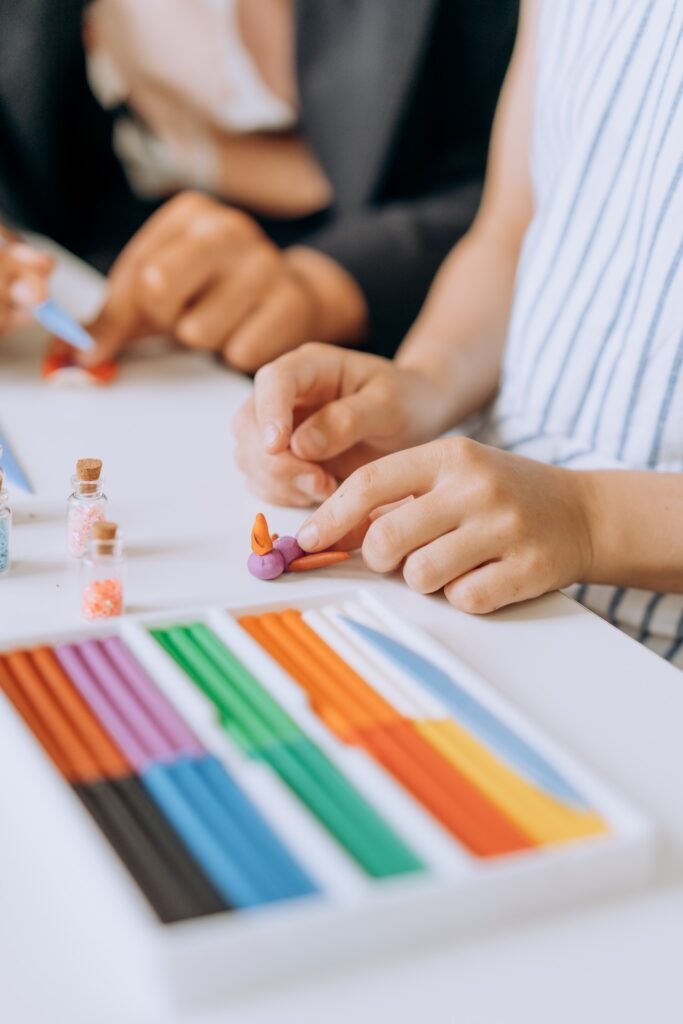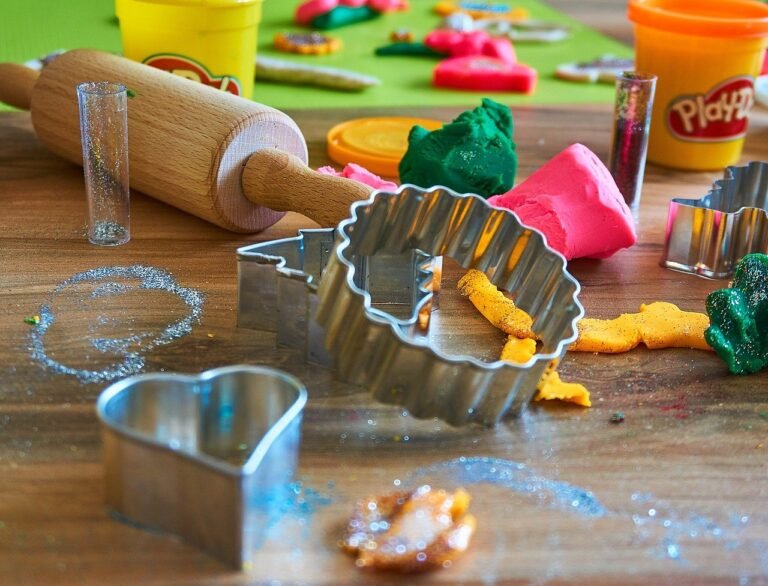Is Plasticine the Same as Play Doh? Know the Difference!
If you kneaded soft mass in different colors between your fingers, and you grew up during the eighties and nineties of the 20th century, probably one type of your game in kindergarten or during elementary school was the one related to mass shaping, known as plasticine. So here is the detailed guide about whether Is plasticine the same as Play doh.
Oil-bound plasticine mass, made of calcium salt, aliphatic acid, gypsum powder, and vaseline, which is easily shaped and retains its shape longer, without drying out because it is bound with oils that do not evaporate. Compared to other materials, plasticine is even considered suitable for professionals.
On the other hand, Play-Doh is a molding compound that is easier to shape, permanent sculptures can be created if left to dry and do not leave greasy stains on the surfaces.
Did You Know?
In the first half of the 20th century, since people in many American homes heated themselves with coal, the Kutol Products soap factory made a flexible mass that was supposed to remove coal dust from wallpaper. This adhesive mass would rely on surfaces to collect particles, leaving no traces, and was quite effective to use.
However, as houses began to be heated by gas after World War II, this mass became useless. However, the owner of the company realized that children were playing by shaping the mass that was the basic product, renamed it “Play-Doh” and thus saved the company from bankruptcy. Isn’t it interesting, that Play-Doh is not planned for the game at all, but for cleaning the wallpaper from the remains of coal dust?!
What is Plasticine Clay used for?
Plasticine is characterized by its softness and the ability to shape into different shapes, very reminiscent of modeling dough. Plasticine sets for children are indispensable assistants in the development of creative potentials, as they enable children and parents to enter the festive atmosphere and become confectioners, doctors, farmers, hairdressers, or just creatives. Because they have a wide range of shades, their masterpieces are bright and colorful.
A variety of entertainment sets allow both children and their parents to enter the festive atmosphere. With their help, you can imagine yourself as a pastry chef, a doctor, a farmer, a hairdresser, and just a dreamer. Made culinary masterpieces are very bright and colorful, every child will want to treat them to a doll. Animals and cartoon characters turn out funny, it’s a pleasure to shape them.
Plasticine clay can also be used as a material for making sculptures, masks, making molds of various shapes, special effects, and animating with clay. This type of clay does not dry, which is extremely useful because it can be used more than once.
What age is Plasticine for? (Is Plasticine the Same as Play Doh)
Plasticine is especially useful from an early age. In working with children, educators, educators, and teachers agree that your child will make the most progress in terms of fine motor skills if they work as much as possible with their palms. Especially if more colors and textures are involved, which is an opportunity provided by playing with plasticine, children are sensory stimulated in several ways. I can distinguish colors, feel the softness of plasticine in the palm of my hand and at the same time, be creative and create different geometric shapes with my own hands, such as a ball, roller, etc.…
At a later age, if you want to fill your free time with some creative activity or have a talent for beauty, you will surely enjoy creating different plasticine items. It is easy to shape, it is modeled under the fingers and tools to work to the smallest details, and the advantage is its consistency, so it does not crumble or dry as is the case with clay if you work without wetting.

Is Plasticine toxic?
Just in case you didn’t know, plasticine clay is made by an art teacher William Harbutt, from Bath England. This non-drying clay was made in 1897 for his students in sculpture, and it was a nontoxic, soft, and malleable clay when you do not expose it to air.
Due to its composition and softness, plasticine is an ideal material for shaping. Since children work with plasticine from the earliest age, it is used somewhere even from the second year of life, the parent’s fear of the risks and dangers that plasticine can cause in their children is justified. The most common risks relate to the amount that a child can eat, while others relate to the fact that there may be suffocation with plasticine if there is an airway.
Of course, no one plans to eat cookies made of plasticine, although they have a nice and mild smell and vivid colors with which you can make different shapes. However, due to the amount of salt that is in the composition of plasticine, they can repel children due to their bitter taste. However, with the use of molds, the fun of making cookies, pastries, and other gastronomic specialties can last far longer.
However, if and when this happens, every parent is interested in how dangerous it is. The human body cannot digest clay, so the harmful effect is minimal. Since it is not poisonous by nature, you do not have to worry if your child swallows a piece of plasticine.
On the other hand, Play-Doh mass contains other ingredients such as salt or baking soda, and if eaten in large quantities can cause stomach problems. It also contains gluten, ie flour, so special care must be taken if the child is allergic and may come into a state of shock due to consuming the mass. You must check all the ingredients before buying Play-Doh mass.
Related: How to Use Sargent Art Plastilina Modeling Clay?
How Do You Stiffen Plasticine?
When you are shaping different types of clay, you know for sure what the differences are in quality and ways of working. What is important to say when it comes to plasticine, you must know that it cannot be baked in an oven or ovens intended for baking polymer clay.
According to the information we have, since plasticine is soft and oil-based, it cannot harden, because its main advantage is that due to its elasticity it can be used several times. In case you still decide to bake plasticine figurines, be prepared for a surprise, since you will be left with a melted mass of irregular shape with drops of oil that have evaporated from this mass.
The only effect you will achieve is melting the mass with lumps and cracks on pieces of undefined mass, it is no longer plasticine or clay… The use of plasticine has more useful things than disadvantages, enjoy them while working with this mason, but do not put shaped figures in the oven, because plasticine cannot harden by baking in the oven.
One of the suggestions to harden plasticine is by coating a layer of PVA glue on wood. This glue is a low-cost, water-based, non-toxic way to glue wood to itself.
Can You Paint Over Plasticine?
As I mentioned earlier in this text, there are types of clay that do not accept colors on themselves. Plasticine is one of them, as it is based on non-absorbent oils. Plasticine remains soft after working with it and is suitable for use with almost no shelf life, regardless of long exposure to air. Most of them can not be made hard and durable.
Although the big advantage is the elasticity and the possibility of working with plasticine, if you want to paint over it, you will have to do some pre-work, before you start painting. The best suggestion we came across is to coat the surface of the figures with a layer of PVA glue for the woods. After the glue hardens and dries, it is possible to apply water-based acrylic paints over it, to achieve the maximum effect of painting your plasticine sculptures.
Although, our sincere recommendation is to work with plasticine colors offered by the manufacturer. The color palette is diverse, and in case you need a certain shade that is not in the offer of basic colors, you can always mix two or more from the package, because it is really easy to work with, mix and manipulate.
Can You Use Acrylic Paint on Plasticine?
As we mentioned earlier, plasticine can not be colored. This is an oil-based clay, which will never dry or harden. It is mostly used for practice making sculptures, and/or for the casting process. In case you need to make a mold or sculpture and cast it in another material, it is designed to be re-molded and re-used, so it cannot be hardened.
We have suggested several alternative ways to paint over plasticine, such as a layer of wood glue. Otherwise, the paint, especially not acrylic, cannot be “caught” by the surface of plasticine, since it is based on oil and does not absorb the paints that are applied to it.
Conclusion
Now that we are at the end of the text, I believe you know more about plasticine than you knew about it at the beginning. Although not suitable for baking and painting with acrylic paints, plasticine has far more advantages in its work. There is no household in which there was no plasticine, as well as a kindergarten where we work with it. It serves for the development of fine motor skills in preschool children, and it also serves as a trigger for other senses, such as the sense of sight and color discrimination.
Students at the Academy of Arts can work with plasticine to create models, masks, and sculptures. With plasticine, you can help your child develop a sense of imagination, as well as stimulate the creative side of his/her mind.
In case you still want a slightly more permanent form of sculpture that you want to bake and save from oblivion, we suggest you look for texts on this blog about other types of clay that you can work with.







